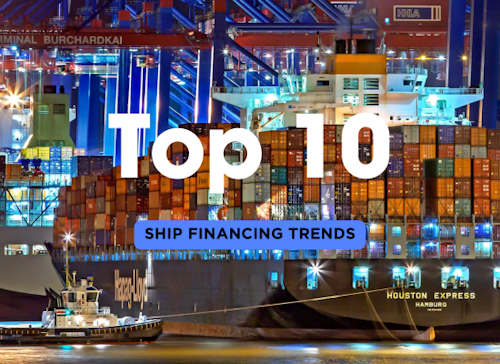Top 10 Trends in Ship Financing

The world of ship financing is undergoing a dynamic transformation, with new trends reshaping how shipowners access capital. From the rise of green financing tied to decarbonization goals to the growing popularity of sale and leaseback agreements, financing models are becoming more diverse and flexible. As banks become more selective, alternative lenders, export credit agencies, and private equity funds are stepping in, offering shipowners more options than ever. Staying ahead of these trends is crucial for anyone looking to modernize fleets or expand operations in an increasingly competitive market.

1. 🌍 Green Financing is Leading the Charge
The shift toward decarbonization is pushing shipowners to embrace green financing options. A large number of banks—approximately three-quarters of global shipping lenders—have adopted the Poseidon Principles, a framework aligning lending decisions with the International Maritime Organization's (IMO) emissions reduction goals. This trend is especially crucial as the cost of decarbonizing the maritime sector by 2050 could range between $1 trillion and $2 trillion. These loans are increasingly being tied to green retrofits, low-carbon new builds, and other eco-friendly upgrades(
Key Fact: Up to $350 billion in investment will be needed by 2030 alone, primarily funded through a mix of bank loans and specialized investment funds.
Why it Matters: Shipowners can access favorable financing rates if they commit to lowering their emissions. This provides not only environmental benefits but also long-term cost savings through reduced fuel consumption and compliance with upcoming regulations.
2. 💸 Leasing Models on the Rise
The withdrawal of traditional Western banks from maritime financing, particularly in Europe, has given rise to Chinese and Japanese leasing companies as dominant players. These lessors offer sale and leaseback (SLB) structures, allowing shipowners to free up capital while retaining operational control of their vessels. With less stringent requirements compared to bank loans, leasing has become a more flexible and competitive option, especially for younger ships.
Key Fact: Chinese leasing companies typically offer higher loan-to-value ratios (70-75%) compared to traditional banks, which often cap their loans at 60%(
Why it Matters: Leasing allows shipowners to expand their fleets or acquire new vessels without significant upfront capital investment, making it easier to manage cash flow and respond to market fluctuations.
3. ⚡ Private Equity and Alternative Funding Sources Expanding
Traditional bank financing has seen increased competition from private equity and other alternative funding sources. These options are becoming especially popular for shipowners seeking quicker financing and higher loan-to-value (LTV) ratios. Funds and private investors often offer higher leverage (up to 75%) compared to banks, making them a desirable choice for expanding fleets and upgrading to more efficient ships. However, these loans may come with strings attached, such as stringent repayment terms or higher interest rates(
Key Fact: Private equity firms and funds are stepping in with flexible financing options, especially for new builds and retrofits tied to greener technologies.
Why it Matters: As traditional lenders tighten their requirements, alternative funding is helping shipowners maintain fleet growth and modernization efforts, but owners must weigh the risks of higher costs or stricter repayment terms.
4. 🌱 The Growing Role of ESG (Environmental, Social, and Governance) Criteria
ESG criteria have increasingly become a determining factor in obtaining ship financing. Lenders, particularly those signed up to the Poseidon Principles, now consider not only a shipowner's creditworthiness but also the environmental and social impact of their fleets. Green retrofits, emissions reductions, and other sustainable initiatives are critical to accessing financing with favorable terms(
Key Fact: ESG-aligned financing options often provide shipowners with lower interest rates and access to capital for retrofits and new builds that meet environmental goals.
Why it Matters: Shipowners focusing on long-term sustainability and aligning with IMO regulations can unlock more competitive financing, ensuring compliance with future regulations and boosting market competitiveness.
5. 📉 Declining Margins and More Selective Bank Lending
Over the past few years, banks have become more selective in their ship financing practices, with lower loan-to-value ratios (LTV) and stricter conditions for lending. Traditional lenders, including the top global banks, are often unwilling to lend more than 50-60% of vessel values, especially for older ships. Margins have also decreased, and banks are placing greater emphasis on cash flow stability and holding company guarantees(
Key Fact: Most banks now prefer younger vessels and more stable sectors, such as container ships and tankers, over dry bulk, due to more predictable earnings.
Why it Matters: Shipowners must prepare for tighter lending conditions by focusing on younger, more efficient fleets or consider alternative financing options such as leasing or private equity.
6. 🏗️ Rise of Sale and Leaseback (SLB) Transactions
Sale and leaseback (SLB) transactions are increasingly popular in ship financing, allowing owners to sell vessels while retaining operational control through long-term leasing agreements. This trend has been driven by tighter bank lending conditions and the flexibility offered by lessors. Chinese and Japanese lessors, in particular, have capitalized on this by providing high LTV ratios and competitive margins(
Key Fact: SLB transactions provide up to 70-75% of the vessel value in financing, making them an attractive option for shipowners looking to free up capital without giving up vessel control.
Why it Matters: Shipowners can expand their fleets or upgrade vessels while maintaining liquidity, but they must carefully navigate the terms and repayment structures associated with leaseback agreements.
7. 📈 Increased Use of Export Credit Agencies (ECAs)
Export Credit Agencies (ECAs) are playing a growing role in ship financing, especially for new builds and complex retrofits. ECAs provide government-backed financing solutions, which are often more attractive for large-scale projects. They help reduce the risk for commercial banks and private lenders, encouraging more investment in new, greener vessels. Countries like China, Japan, and South Korea are particularly active in offering ECA-backed financing for their shipyards(
Key Fact: ECAs often offer longer repayment terms and lower interest rates than traditional commercial banks, making them ideal for large-scale ship orders.
Why it Matters: Shipowners planning large fleet expansions or green retrofits can leverage ECA financing to secure better terms and reduce reliance on traditional lenders.
8. 🌐 Digitalization and Tech-Driven Financing Solutions
Digitalization in ship financing is transforming how transactions are processed and monitored. Blockchain technology, in particular, is being explored to improve transparency, streamline transactions, and reduce the risk of fraud. Platforms that digitize ship financing processes are becoming more popular, allowing for faster approvals and more efficient financing structures. For example, blockchain solutions are being used to create secure, transparent smart contracts in leasing and sale agreements(
Key Fact: Digital platforms can speed up financing approval times significantly and reduce paperwork, allowing shipowners to access funds more quickly.
Why it Matters: Embracing digital solutions can give shipowners a competitive edge by reducing transaction times, increasing transparency, and allowing for more secure and efficient financial management.
9. 💼 Hybrid Financing Models
As the financial landscape for shipping becomes more complex, hybrid financing models are emerging. These models combine traditional bank loans with alternative funding sources, such as private equity, leasing, and export credit agencies (ECAs). This diversification helps shipowners secure more capital while spreading risk across different types of lenders. Hybrid financing models are particularly attractive for large projects that require both immediate liquidity and long-term capital(
Key Fact: Hybrid models can include a mix of sale and leaseback deals, traditional loans, and ECA support, providing more flexibility for shipowners looking to expand or retrofit their fleets.
Why it Matters: By utilizing hybrid financing, shipowners can access the capital they need while maintaining more manageable repayment terms and reducing dependence on a single financing source.
10. 🔄 Focus on Fleet Modernization and Retrofitting
With stricter environmental regulations and rising fuel costs, shipowners are increasingly focusing on fleet modernization and retrofitting. Financing for retrofits, such as installing energy-efficient engines or alternative propulsion systems, is becoming more available, especially from green finance lenders and specialized funds. These projects are often funded through longer-term financing arrangements, with repayment structures tied to expected fuel savings and lower emissions(
Key Fact: Retrofitting a vessel can cost between $1 million and $1.5 million, but the payback period is often under two years, especially when factoring in fuel savings and emission trading schemes(
Why it Matters: Shipowners looking to stay competitive and meet regulatory demands must prioritize fleet upgrades. Financing these projects is critical for long-term operational savings and compliance with future industry standards.
The landscape of ship financing is evolving rapidly, driven by a mix of environmental pressures, regulatory changes, and innovative financing models. From green loans and sale-and-leaseback agreements to hybrid financing structures and the increased role of digital solutions, shipowners have more options than ever to fund their operations. Navigating this complex environment requires a strategic approach to capital allocation, with a focus on sustainability, operational efficiency, and risk management. By staying informed about these key trends, shipowners can secure the financing they need to thrive in a competitive global market.
Table Summary
| ShipUniverse: Top 10 Trends in Ship Financing | |
|---|---|
| Trend | Details |
| 🌍 Green Financing | With banks increasingly aligning their loans with environmental goals, green financing is key for shipowners committed to decarbonization. Ships with eco-friendly retrofits or alternative fuel systems are more likely to secure favorable loan terms, especially from banks following the Poseidon Principles. |
| 💸 Leasing Models on the Rise | Chinese and Japanese leasing companies are offering flexible sale and leaseback (SLB) agreements, providing up to 75% loan-to-value ratios. This trend is particularly attractive for shipowners needing capital while maintaining operational control of vessels. |
| ⚡ Private Equity and Alternative Funding | Private equity firms and alternative funds are filling the gap left by traditional banks, offering shipowners quicker access to capital and higher leverage. These funding sources are ideal for fleet expansions but may come with higher interest rates and stricter conditions. |
| 🌱 ESG Criteria | Environmental, Social, and Governance (ESG) factors are becoming critical for accessing ship financing. Lenders now prioritize green initiatives, meaning shipowners with a focus on sustainability can unlock better financing options. |
| 📉 Declining Margins and Stricter Lending | Banks are tightening their ship financing terms, offering lower loan-to-value ratios (around 50-60%). Older ships and volatile sectors like dry bulk are facing tougher lending conditions, making alternative financing sources more attractive. |
| 🏗️ Sale and Leaseback Transactions | SLB agreements are becoming a preferred method for ship financing, especially in regions where traditional bank loans are harder to secure. Shipowners can free up capital while keeping operational control of their vessels, often with more flexible repayment terms. |
| 📈 Export Credit Agencies (ECAs) | ECAs are stepping in to provide long-term financing for new builds and major retrofits, often at lower interest rates and with longer repayment terms than traditional banks. This is particularly common in China, Japan, and South Korea. |
| 🌐 Digital and Tech-Driven Financing | Blockchain technology and digital platforms are speeding up financing transactions and improving transparency. These innovations make it easier to secure funds quickly, offering a more streamlined approach to ship financing. |
| 💼 Hybrid Financing Models | Hybrid models, combining bank loans, leasing, and private equity, are helping shipowners access more capital with diversified risk. These models are becoming essential for large projects or major fleet upgrades. |
| 🔄 Fleet Modernization and Retrofitting | With rising fuel costs and stricter environmental regulations, retrofitting ships with energy-efficient technologies is a top priority. Financing these retrofits is critical, and green finance lenders are providing more options for these long-term investments. |

Do you have a Maritime Product or Service that may be of interest to Shipowners? Tell us about it here!
Do you have feedback or insights? Please reach out to editor @ shipuniverse.com



